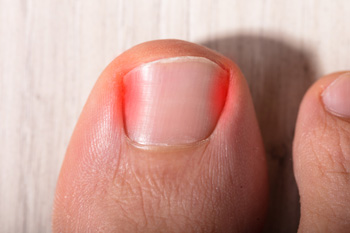
Ingrown toenails can be painful and persistent, but treatment options continue to evolve. Conservative care remains a first step for many. This includes warm salt soaks, gentle lifting of the nail edge, or protective padding to reduce pressure. Proper trimming techniques and footwear changes can also help prevent recurrence. When conservative measures do not bring relief, more advanced options may be considered. Newer treatments include partial nail removal combined with techniques to prevent regrowth along the problematic edge. This offers a long-term solution with minimal discomfort. In some cases, laser or chemical procedures are used to address the nail root directly. With both time-tested and modern approaches available, treatment can be tailored to fit each person’s needs and lifestyle. If you have recurring or painful ingrown toenails, it is suggested that you schedule an appointment with a podiatrist for a diagnosis and treatment deemed best for you.
Ingrown toenails may initially present themselves as a minor discomfort, but they may progress into an infection in the skin without proper treatment. For more information about ingrown toenails, contact one of our podiatrists of New York, NY. Our doctors can provide the care you need to keep you pain-free and on your feet.
Ingrown Toenails
Ingrown toenails are caused when the corner or side of a toenail grows into the soft flesh surrounding it. They often result in redness, swelling, pain, and in some cases, infection. This condition typically affects the big toe and may recur if it is not treated properly.
Causes
- Improper toenail trimming
- Genetics
- Improper shoe fitting
- Injury from pedicures or nail picking
- Abnormal gait
- Poor hygiene
You are more likely to develop an ingrown toenail if you are obese, have diabetes, arthritis, or have any fungal infection in your nails. Additionally, people who have foot or toe deformities are at a higher risk of developing an ingrown toenail.
Symptoms
Some symptoms of ingrown toenails are redness, swelling, and pain. In rare cases, there may be a yellowish drainage coming from the nail.
Treatment
Ignoring an ingrown toenail can have serious complications. Infections of the nail border can progress to a deeper soft-tissue infection, which can then turn into a bone infection. You should always speak with your podiatrist if you suspect you have an ingrown toenail, especially if you have diabetes or poor circulation.
If you have any questions, please feel free to contact our office located in New York, NY . We offer the newest diagnostic and treatment technologies for all your foot care needs.

